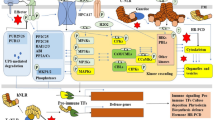Abstract
Antimicrobial peptides offer a new method for controlling pathogens, however, many promising peptides are too small for direct production in plants. A protein delivery system was developed based on a proteolytic mechanism used by Solanaceous plants to produce the very small (18 amino acid) signaling peptide systemin from the polypeptide prosystemin. Fusion of the gene encoding the 23 kDa protein prosystemin with the antimicrobial peptide (pep11) sequence, replacing the systemin sequence, allowed for expression in transgenic tomato plants. Six days after inoculation with the late blight pathogen Phytophthora infestans, detached leaflets of transgenic tomato (Rutgers) exhibited a reduction in lesion size of at least 50 percent.
Similar content being viewed by others
References
Caten C.E. and Jinks J.L. 1968. Spontaneous variability of single isolates of Phytophthora infestans. I Cultural variation. Canad. J. Bot. 46: 329–348.
Cavallarin L., Andreu D. and San Segundo B. 1998. Cercropin Aderived peptides are potent inhibitors of fungal plant pathogens. Molec. Plant Microbe Inter. 11: 218–227.
Constabel C.P., Yip L. and Ryan C.A. 1998. Prosystemin from potato, black nightshade, and bell pepper: primary structure and biological activity of predicted systemin polypeptides. Plant Mol. Biol. 36: 55–62.
Del Sal G., Storici P., Schneider C., Romeo D. and Zanetti M. 1992. cDNA cloning of the neutrophil bactericidal peptide indolicidin. Biochem. Biophys. Res. Commun. 187: 467–472.
Dombrowski J.E., Pearce G. and Ryan C.A. 1999. Proteinase inhibitor-inducing activity of the prohormone prosystemin resides exclusively in the C-terminal systemin domain. Proc. Natl. Acad. Sci. USA 96: 12947–12952.
Duvick J.P., Rood T., Rao A.G. and Marshak D.R. 1992. Purification and characterization of a novel antimicrobial peptide from maize (Zea maysL.) kernels. J. Biol. Chem. 267: 18814–18823.
Francois I.E.J.A., DeBolle M.F.C., Dwyer G., Goderis I.J.W.M., Woutors P.F.J., Verhaert P.D., Proost P., Schaaper W.M.M., Cammue B.P.A. and BroekaertW.F. 2002. Transgenic expression in Arabidopsisof a polyprotein construct leading to production of two different antimicrobial proteins. Plant Physiol. 128: 1346–1358.
Fry W.E. and Goodwin S.B. 1997. Re-emergence of potato and tomato late blight in the United States. Plant Disease 81: 1349–1357.
Gao A-G, Hakimi S.M., Mittanck C.A., Wu Y., Woerner B.M., Stark D.M., Shah D.M., Liang J. and Rommens C.M.T. 2000. Fungal pathogen protection in potato by expression of a plant defensin peptide. Nat. Biotechnol. 18: 1307–1310.
Hancock R.E.W. and Leher R. 1998. Cationic peptides: a new source of antibiotics. TIBTECH 16: 82–88.
Jones R.W. 2000. Analysis of prosystemin in potato. (Abstr.) Am. J. Potato Res. 77: 404.
Kazan K., Rusu A., Marcus J.P., Goulter K.C. and J.M. Manners. 2002. Enhanced quantitative resistance to Leptosphaeria maculansconferred by expression of a novel antimicrobial peptide in canola (Brassica napusL.). Mol. Breeding 10: 63–70.
Marcus J.P., Green J.L., Goulter K.C. and Manners J.M. 1999. A family of antimicrobial peptides is produced by processing of a 7S globulin protein in Macadamia integrifoliakernels. Plant J. 19: 699–710.
McCormick S., Niedermeyer J., Fry J., Barnason A., Horsch R., and Fraley R., 1986. Leaf disc transformation of cultivated tomato (L. esculentum) using Agrobacterium tumefaciens. Plant Cell Rep. 5: 81–84.
Nizet V., Ohtake T., Lauth X., Trowbridge J., Rudisill J., Dorschner R.A., Pestonjamasp V., Piraino J., Huttner K. and Gallo R.L. 2001. Innate antimicrobial peptide protects the skin from invasive bacterial infection. Nature 414: 454–457.
Okamoto M., Mitsuhara I., Ohshima M., Natori S. and Ohashi Y. 1998. Enhanced expression of an antimicrobial peptide sarcotoxin IA by GUS fusion in transgenic tobacco plants. Plant Cell Physiol. 39: 57–63.
Osusky M., Zhou G., Osuska L., Hancock R.E., Kay W.W. and Misra S. 2000. Transgenic plants expressing cationic peptide chimeras exhibit broad-spectrum resistance to phytopathogens. Nature Biotechnol. 18: 1162–1166.
Owens L.D. and Heutte T.M. 1997. A single amino acid substitution in the antimicrobial defense protein cercropin B is associated with diminished degradation by leaf intercellular fluid. Molec. Plant Microbe Inter. 10: 525–528.
Park I.Y., Park C.B, Kim M.S. and Kim S.C. 1998. Parasin I, an antimicrobial peptide derived from histone H2A in the catfish, Parasilurus asotus. FEBS Letters 437: 258–262.
Putsep K., Normark S. and Boman H.G. 1999. The origin of cercropins; implications from synthetic peptides derived from ribosomal protein L1. FEBS Letters 451: 249–252.
Schaller A. and Ryan C.A. 1995. Systemin-a polypeptide defense signal in plants. BioEssays 18: 27–33.
Segura A., Moreno M., Madueno F., Molina A. and Garcia-Olmedo F. 1999. Snakin-1, a peptide from potato that is active against plant pathogens. Molec. Plant Microbe Inter. 12: 16–23.
Tailor R., Acland D.P., Attenborough S., Cammue B.P.A., Evans I.J., Osborn R.W., Ray J.A., Rees S.B. and BroekaertW.F.. 1997. A novel family of small cysteine-rich antimicrobial peptides from seed of Impatiens balsamina is derived from a single precursor protein. J. Biol. Chem. 272: 24480–24487.
Terras F.R.G., Eggermont K., Kovaleva V., Raikhel N.V., Osborn R.W., Kester A., Rees S.B., Torrekens S., Van Leuven F., Vanderleyden J., Cammue B.P.A. and Broekaert W.F. 1995. Small cysteine-rich antifungal proteins from radish: their role in host defense. The Plant Cell 7: 573–588.
Van der Biezen E.A. 2001. Quest for antimicrobial genes to engineer disease-resistant crops. Trends in Plant Sci. 6: 89–91.
Vetsch M., Janzik I. and Schaller A. 2000. Characterization of prosystemin expressed in the baculovirus/insect cell system reveals biological activity of the systemin precursor. Planta 211: 91–97.
Yang H., Matsubayashi Y., Hanai H. and Sakagami Y. 2000. Phytosulfokine-alpha, a peptide growth factor found in higher plants: its structure, functions, precursor and receptors. Plant Cell Physiol. 41: 825–830.
Author information
Authors and Affiliations
Rights and permissions
About this article
Cite this article
Jones, R.W., Ospina-Giraldo, M. & Clemente, T. Prosystemin-antimicrobial-peptide fusion reduces tomato late blight lesion expansion. Molecular Breeding 14, 83–89 (2004). https://doi.org/10.1023/B:MOLB.0000038001.22029.07
Issue Date:
DOI: https://doi.org/10.1023/B:MOLB.0000038001.22029.07




